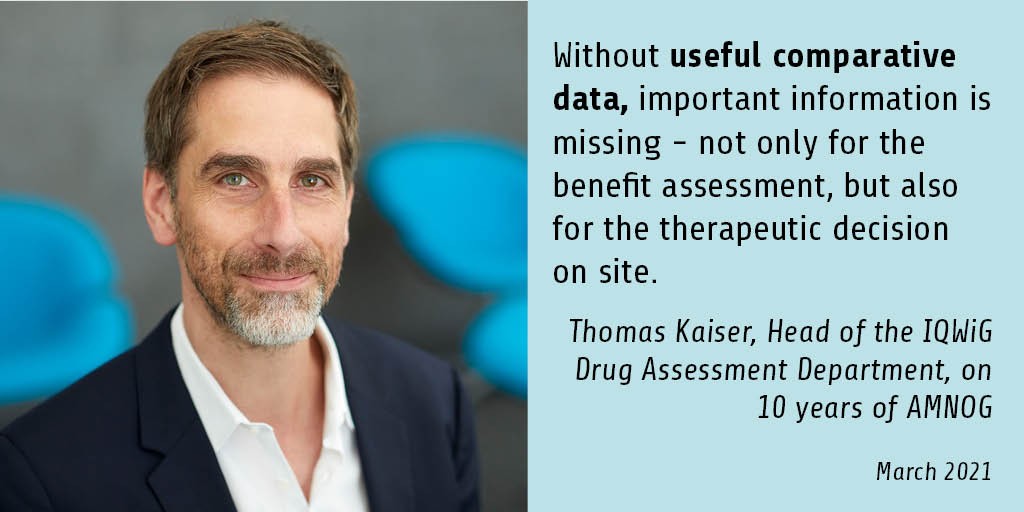Mar 19, 2021
Early benefit assessment - the whole range
IQWiG assessed a total of 24 manufacturer dossiers on time for the deadlines of 1 March and 15 March. As examples, the indications and results reflect the complexity of the AMNOG procedure.
"The AMNOG procedure has passed its first practical test. It is practicable and can also be implemented in detail", emphasized IQWiG’s Director Jürgen Windeler in October 2011, when the Institute had published its first early benefit assessment within the framework of the AMNOG procedure (AMNOG = Act on the Reform of the Market for Medicinal Products). At that time, the Institute for Quality and Efficiency in Health Care (IQWiG) had certified that the coagulation inhibitor ticagrelor had a considerable added benefit for certain patient groups. The Federal Joint Committee (G-BA) followed this scientific expertise in its decision on the added benefit. Today, 10 years after the AMNOG came into force, the early benefit assessment of new drugs, which was initially viewed very critically, has long been established in Germany and enjoys an excellent international reputation.
Many different therapeutic indications and various reasons for commissioning
A look at the 24 dossier assessments completed by the Institute on the deadlines of 1 March and 15 March shows how diverse the range of indications and the specific reasons for commissioning the Institute in the context of the early benefit assessment are:
The indications range from cancer diseases via epilepsy, chronic kidney diseases, rare diseases such as cystic fibrosis, transthyretin amyloidosis and spinal muscular atrophy to chronic heart failure and psoriasis with joint inflammation. All eligible reasons of the G-BA for commissioning IQWiG with an early benefit assessment are also represented at the publication date of March 2021: the classic new approval of a drug, the expanded approval of a known drug for an additional therapeutic indication, the reassessment of a drug after expiry of approval or due to the availability of new study data, and cases in which the annual turnover of a drug for the treatment of a rare disease (orphan drug) exceeds the threshold of 50 million euros.
Wide range of assessment results
Possible results of IQWiG dossier assessments range from "lesser benefit" (i.e. inferiority in comparison with standard treatment) and "no added benefit" via "minor added benefit" up to "considerable added benefit" and finally to "major added benefit" as the highest assessment category.
In the early benefit assessments just published in March 2021, the Institute exploits all facets of this spectrum: For example, it certifies nusinersen a major added benefit versus best supportive care in the treatment of children with spinal muscular atrophy and early onset of disease. For olaparib, in contrast, IQWiG sees lesser benefit for the treatment of pancreatic cancer compared to watchful waiting. Over the past ten years, the Institute has recognised an added benefit in about 40 percent of the early benefit assessments, in half of them with the extents “considerable” or “major”. All assessment results of IQWiG and the underlying data are freely accessible - on www.iqwig.de. Internationally, AMNOG is highly praised for this transparency.
Not every study of the approval is suitable
The data quality in the dossiers submitted by the manufacturers to IQWiG for the early benefit assessment of their drugs is also very diverse. This also applies exemplarily to the dossier assessments just published in March 2021: In some cases, the data are incomplete or do not allow a comparison with the appropriate comparator therapy defined by the G-BA. "Without sound comparative data, important information is missing - not only for the benefit assessment, but also for the therapeutic decision on site", emphasizes Thomas Kaiser, Head of the IQWiG Drug Assessment Department.
The problem: "The clinical studies of the manufacturers often concentrate primarily on the fulfilment of the requirements stipulated by the regulatory authorities and less on the important research question of the benefit assessment: What is the value of the new drug compared to the present standard therapy?", explains the Head of the IQWiG Drug Assessment Department. He appeals to the manufacturers to also consider the requirements for the benefit assessment in the studies or to conduct their own studies for the benefit assessment. “Ten years after the AMNOG came into force, it can no longer be an argument that the requirements for the benefit assessment were not known at the time the study was planned.”


